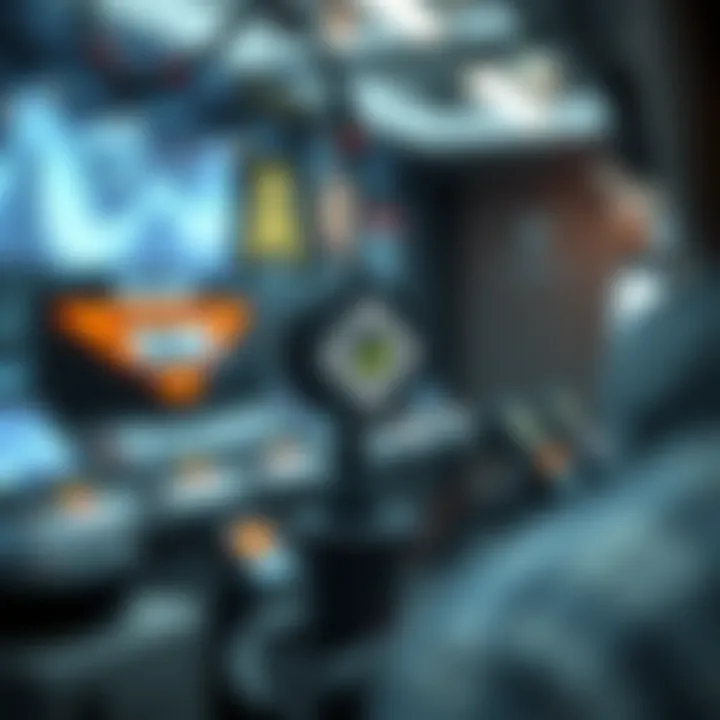Exploring Solanart: NFTs and Cryptocurrency Dynamics


Intro
In the world of digital assets, Solanart has emerged as a significant player, carving its niche within the Solana blockchain landscape. As the demand for non-fungible tokens (NFTs) continues to soar, Solanart stands out not just as a marketplace but as a pivotal ecosystem that connects creators, collectors, and investors alike. With the rise of NFTs transforming how art, music, and collectibles are bought and sold, understanding Solanart’s role is crucial for anyone interested in the intersection of technology and investment.
Navigating the intricacies of Solanart requires a solid comprehension of cryptocurrency fundamentals. Before delving into the unique aspects of this platform, it is essential to explore the basics of cryptocurrency as a whole, laying the groundwork for a well-rounded discussion on how Solanart fits into the larger narrative. This approach not only empowers newcomers to grasp essential concepts but also reignites sparks of insight for seasoned enthusiasts.
As we embark on this exploration, we will dissect the operational mechanisms of Solanart, examine emerging market trends, and gauge potential future developments that could impact this flourishing marketplace. We'll provide a comprehensive overview, allowing both avid investors and casual tech enthusiasts to deepen their understanding and appreciation of this evolving digital asset space.
Intro to Solanart
Solanart is carving out its space in the dynamic world of non-fungible tokens (NFTs) and the broader cryptocurrency landscape. Serving as a pivotal marketplace, it embodies the synergy between innovative blockchain technology and creative digital asset management. This introduction offers a glimpse into the significance of Solanart, especially for investors, tech enthusiasts, and educators alike.
First off, it's essential to grasp what Solanart brings to the table. In a crowded marketplace of NFT platforms, it stands out due to its efficiency, speed, and low transaction costs. Unlike some of its counterparts, which might bog users down with high fees and slow transaction times, Solanart operates on the Solana blockchain, known for its impressive scalability. The blockchain enables transactions to occur in mere seconds, which is critical for a marketplace focused on visual art and collectibles.
The benefit of using Solanart is multifaceted. First, it empowers creators by allowing them to mint their NFTs with relative ease. Artists can tokenize their artwork, transforming it from a tangible piece into a digital asset that carries potential monetary value. This assures an affordable entry point for creators who may not have the resources to engage smaller, niche markets.
Moreover, the marketplace hosts a diverse range of NFTs, from digital art to music tracks and even domain names. This diversity attracts a wide audience, looking to invest in various digital assets while providing artists with a broader platform to showcase their talents.
However, like any investment opportunity, there are considerations to heed. Newcomers might find the technological jargon overwhelming. Gaining a solid understanding of crypto wallets, transactions, and blockchain fundamentals is crucial for navigating the platform without hiccups. Understanding these key elements will enhance the user's experience and avoid pitfalls.
In summary, Solanart is not just another NFT marketplace; it signifies a convergence of technology and creativity. As we delve deeper into this article, we will explore its mechanisms, role in cryptocurrency, and what the future holds for this innovative platform. Through this comprehensive overview, readers can appreciate both the foundational knowledge and the emerging opportunities within Solanart.
Understanding Non-Fungible Tokens
The term non-fungible tokens, often shortened to NFTs, is key in the context of digital ownership. They represent unique digital assets that cannot be exchanged on a one-to-one basis like cryptocurrencies such as Bitcoin or Ethereum. Understanding NFTs is crucial, especially as Solanart operates within this dynamic environment. These tokens are changing how we perceive value in the digital realm, influencing everything from art to gaming.
Definition and Characteristics
NFTs can be defined as digital certificates of ownership, leveraging blockchain technology to ensure authenticity and provenance. Unlike fungible tokens, where each unit holds the same value (think of dollars or bitcoins), non-fungible tokens are unique. Each NFT can convey specific information that sets it apart, be it a piece of art, a virtual land plot, or a unique character in a game.
Key characteristics of NFTs include:
- Indivisibility: Unlike cryptocurrencies, NFTs cannot be broken down into smaller units. You either own the whole asset or none of it.
- Authenticity: Every NFT has a unique identifier recorded on the blockchain, making it easy to verify its authenticity and ownership history.
- Interoperability: Many NFTs, especially those minted on Ethers and Solana, can be traded across various platforms, enhancing their liquidity.
- Ownership Rights: Buying an NFT doesn’t always mean buying the copyright of the underlying asset. It’s essential to read the fine print to understand what rights you’re acquiring.
Comparison with Fungible Tokens
When we stack NFTs alongside fungible tokens, like cryptocurrencies, the differences are striking. Fungible tokens are designed for smooth transactions and consistent value across the board. Take Bitcoin, for instance; one BTC is equal to another, making it perfect for trading or as a currency. Meanwhile, NFTs are inherently varied and have value based on their uniqueness and the demand for that specific asset.
Some notable contrasts include:
- Value Determinants: While the market value of fungible tokens largely depends on supply and demand, NFT values derive from rarity, cultural significance, and desirability.
- Transactions: Transactions involving fungible tokens are often straightforward and guided by market rates. In contrast, buying or selling NFTs requires knowledge about the specific asset and its market context.
- Market Behavior: NFTs could see surges in value based on trends or notable sales, making the market more volatile than that of fungible tokens, which tend to move according to broader economic indicators.
Historical Context of NFTs
Diving into the history of non-fungible tokens adds layers to our understanding. NFTs are a relatively new phenomenon, having emerged around 2015 with projects such as Cryptopunks and later the rise of Ethereum-based platforms fostering their growth. 2017 marked a turning point when CryptoKitties captivated collectors worldwide, highlighting the potential of NFT technology.
As time went on, the concept of ownership and value in the digital space began to shift drastically. By 2020 and into 2021, the NFT market exploded, driven by high-profile artists and brands entering the scene, often fetching extraordinary sums at auction. An iconic sale in early 2021 saw a digital artwork sell for over $69 million, signaling the mainstream acceptance of this technology.
This evolution paved the way for platforms like Solanart, which caters specifically to the marketplace of NFTs, demonstrating how these tokens have not only redefined ownership but have also become a significant part of the digital economy. As the landscape continues to unfold, understanding the nuances of NFTs is more pivotal than ever.
The Solana Blockchain
The Solana blockchain stands at the forefront of the current cryptocurrency wave. Offering a unique blend of speed, efficiency, and low costs, it’s an attractive platform for both developers and investors. Understanding its architecture and benefits can shed light on its role in facilitating the operations of marketplaces like Solanart.
Overview of Blockchain Technology
To grasp what makes Solana special, one must first understand the fundamentals of blockchain technology. At its core, a blockchain is a distributed ledger that securely records transactions across many computers. This decentralization means that no single entity governs the flow of data, thus enhancing security and trust.


Blockchain works through a consensus mechanism, ensuring that all participants agree on transaction validity. The beauty lies in its transparency and immutability, meaning once data is recorded, it's practically impossible to alter it. This foundation has given rise to various applications, including cryptocurrencies and NFTs. In fact, Solana leverages its blockchain to support complex smart contracts, paving the way for innovative financial products and services.
Scalability and Performance
Scalability is a major concern across various blockchain networks. Many platforms face congestion and high transaction fees due to limited throughput. However, Solana addresses these pain points with a unique solution. It boasts a remarkable processing speed of up to 65,000 transactions per second—significantly higher than Ethereum, which can handle merely 30 transactions per second.
This performance is achieved through mechanisms like Proof of History (PoH), which helps synchronize the network's operations, and helps to manage tasks effectively. The low latency means users can expect fast confirmations of transactions, maintaining a fluid experience when interacting with platforms like Solanart. Furthermore, transaction fees on Solana are quite nominal, often amounting to just a few cents—for a digital asset marketplace, this is a game-changer.
Advantages of Solana Over Other Blockchains
What sets Solana apart from other blockchains? While Ethereum has pioneered the NFT space, Solana is making waves of its own by offering several advantages:
- Speed and Efficiency: As noted, the high transaction speed combined with low costs transforms user experience. Artists can mint and sell their artworks with minimal fees, encouraging participation.
- Growing Ecosystem: Solana has a rapidly expanding ecosystem, housing various applications beyond NFTs, such as decentralized finance (DeFi) solutions. This diversity attracts a broader audience.
- Developer-Friendly: The architecture of Solana is designed to be developer-friendly. It supports popular programming languages such as Rust, providing a smooth onboarding experience for developers looking to create new solutions.
- Community Support: The Solana community is vibrant and actively supports projects through various funding initiatives. This backing can help new developers bring their ideas to fruition with less friction.
In summary, Solana's technological advancements and economic model offer a refreshing alternative in the cryptospace when it comes to building and trading NFTs. This makes it an ideal platform for Solanart to thrive, ensuring its relevance in the ongoing evolution of digital assets.
Navigating the Solanart Marketplace
Navigating the Solanart marketplace offers a unique opportunity to delve into the world of NFTs on the Solana blockchain. It’s essential to understand not just how to maneuver through the platform but also the advantages this navigation brings. Solanart simplifies the often complex process associated with buying, selling, and minting NFTs, making them accessible for everyone from casual browsers to serious investors.
Understanding the user interface, minting processes, and transaction procedures can empower users, ensuring they maximize the value they obtain from their digital assets. Here are some specific elements worth noting:
- User-Friendliness: The layout is intuitive, catering to both newcomers and seasoned crypto enthusiasts.
- Transaction Efficiency: With Solana’s speed, users can complete transactions in a fraction of the time compared to other blockchains.
- Ecosystem Integration: Interconnected features allow users to explore a variety of NFTs seamlessly.
Here’s a closer look at key aspects of the marketplace:
User Interface and Experience
The interface of Solanart is designed with user experience at its core. Upon entering, you’ll find a clean, organized layout where essential functionality is just a click away. The navigation bar allows you to easily access various sections without any convoluted steps. This simplicity helps reduce the friction often felt when dealing with new technology.
Critical components include:
- Search Functionality: Users can easily find specific NFTs or categories they are interested in.
- Filter Options: Options to filter by price, popularity, and type of NFT provides a customized browsing experience.
- Responsive Design: It adapts well whether you’re accessing from a desktop or mobile, ensuring a smooth experience no matter the device.
Furthermore, an aesthetic appeal enhances the overall experience, making the process of viewing artwork enjoyable. Solanart prioritizes not just functionality but also visual engagement with smooth interactions and vivid representations of listings.
Creating and Minting NFTs
Minting NFTs on Solanart is notably straightforward, making it a viable option for artists and creators looking to showcase and sell their work. The process begins by connecting a digital wallet, allowing users to manage their assets efficiently.
Key steps include:
- Wallet Connection: Users first need to connect their wallets; compatible options include Phantom or Sollet among others.
- Asset Upload: Creators can easily upload their digital files, which can range from images to music, providing many options for creativity.
- Setting Details: After uploading, users specify the NFT's name, description, and any royalties on future sales which further incentivizes creators.
Upon completion, a user clicks “Mint,” and voilà, the new NFT is part of Solanart’s vibrant marketplace. The speed at which minting occurs, thanks to Solana’s underlying technology, sets the stage for an efficient workflow.
Buying and Selling Procedures
For buying and selling on Solanart, a keen understanding of the procedures enhances transaction success. The steps taken during these processes can greatly affect the investment's overall effectiveness.
Buying NFTs:
- Exploration: Users can explore various NFTs, assessing their desirability through visuals and metadata.
- Bidding or Purchasing: Depending on the listing, users can either place a bid or buy instantly if it’s a fixed-price sale.
- Transaction Confirmation: Once a purchase is made, a confirmation within the wallet ensures the asset is securely transferred.
Selling NFTs:
- Listing for Sale: Sellers can choose to list their NFTs at a fixed price or opt for an auction format.
- Marketing Considerations: To maximize visibility, good practice involves promoting listings through social media channels or community forums.
- Revising Listings: Sellers can make adjustments to their listings for better pricing or more attractive descriptions at any time prior to sale.
The ease with which transactions are handled within Solanart fosters an inviting atmosphere for newcomers, while seasoned users appreciate the efficiency that accompanies using the platform.


In summary, navigating Solanart is a well-structured journey through an engaging market landscape where both buyers and sellers can thrive. As you learn to wield the tools available, you’ll find that the platform not only simplifies the NFT experience but also amplifies its potential. By combining user-friendly design, minting accessibility, and straightforward transaction processes, Solanart stands as a key player in the ever-evolving world of digital assets.
"Navigating the Solanart marketplace can turn aspirations into tangible digital assets, promoting creativity and investment accessibility."
For further insights and resources, you might find this link useful: Solanart.
Tokenomics of Solanart
Understanding the tokenomics of Solanart is pivotal for grasping its operational dynamics and long-term viability. Tokenomics refers to the economic model behind a cryptocurrency or a blockchain-based platform, detailing the utility, distribution, and mechanisms that govern tokens within an ecosystem. In the case of Solanart, its tokenomics not only supports the functionality of the platform but also influences investor sentiment and market engagement.
A well-structured tokenomics model is crucial as it determines how users interact with the platform and, ultimately, the success of its economy. Factors such as token utility, scarcity, and incentives play a vital role in attracting participation from both creators and collectors in the NFT space. Understanding these elements will provide insights into the platform's growth potential and the sustainability of its market presence.
SOL Token Utility
The SOL token is the native currency of the Solana ecosystem and holds significant importance within the Solanart marketplace. Its utility can be seen in various ways:
- Transaction Fees: Users are required to pay transaction fees in SOL when buying or minting NFTs on Solanart. This creates a direct demand for the token, incentivizing holding and usage.
- Staking Opportunities: Users can stake their SOL tokens to earn rewards, ensuring that there is a mechanism in place for token holders to benefit from participating in the network.
- Access to Exclusive Features: Holding SOL tokens can provide preferential access to certain marketplace features, thus enhancing user engagement.
This practical application of the SOL token helps solidify its status as a cornerstone of Solanart’s operation, fostering a vibrant economy that encourages widespread participation.
Fee Structure and Revenue Model
The fee structure and revenue model of Solanart are essential components in ensuring the platform's sustainability. Here's how it breaks down:
- Marketplace Fees: Solanart typically charges a percentage fee on each NFT transaction, which can vary based on market conditions and platform promotions. This ensures a steady revenue stream while maintaining competitiveness with other NFT marketplaces.
- Creator Royalties: Artists and NFT creators can set a percentage of royalties for secondary sales, allowing them to earn from the resales of their works. This not only benefits creators but also enhances the value of the NFTs traded on the platform.
"The fee structure is designed not just for profitability; it also empowers artists, ensuring they receive fair compensation for their work."
- Additional Services: Solanart may offer premium services, such as enhanced visibility for NFT listings or promotion campaigns. This diversifies revenue streams while adding value for users.
In essence, the fee structure is designed to balance affordability for users with profitability for the platform. A thoughtful approach to revenue ensures that Solanart can continue expanding its offerings and support a thriving community of creators and collectors.
Market Trends and Insights
Understanding market trends and insights is crucial for anyone interested in the synergy between NFTs and cryptocurrency, especially within the Solanart platform. Analyzing these trends can give investors, tech enthusiasts, and educators a better grasp of the landscape and its future trajectory. As the NFT space continues evolving, keeping finger on the pulse of current behaviors and preferences will enable stakeholders to navigate effectively.
Current Market Position of Solanart
Solanart has firmly planted itself in the digital art and collectibles marketplace, standing shoulder to shoulder with other prominent NFT platforms. As of now, it has established its presence as a go-to hub for NFT dealings within the Solana ecosystem. The platform leverages Solana's high-speed transactions and lower fees, making it appealing to creators and collectors alike.
Data indicates a surge in listings and transactions on Solanart, particularly among digital artists and gamers who are flocking to its user-friendly interface.
- Creator Engagement: Many artists report improved sales since they can mint NFTs with minimal costs and list them effortlessly.
- Collector Diversity: The marketplace attracts a rich tapestry of collectors, from casual buyers hunting for interesting pieces, to serious investors betting on long-term value appreciation.
- Volume Growth: Reports highlight that Solanart has seen its trading volume grow, approaching figures that put it on par with larger, more established marketplaces.
This rapid growth indicates that Solanart is not just surviving but thriving, consequently impacting the NFT and crypto market at large.
NFT Valuation Dynamics
Valuing NFTs remains a complex undertaking, as various factors come into play. Many variables encompass scarcity, demand, community backing, and artist reputation. Each of these aspects can either escalate or diminish the perceived worth of a digital asset.
Key determinants for NFT valuation include:
- Scarcity: Artists have the ability to limit the number of available pieces significantly. NFTs perceived as rare often see skyrocketing prices.
- Market Demand: Trends in collector interest can fluctuate rapidly, influencing how much someone is willing to pay.
- Community and Social Proof: The backing of a creator's community can bolster interest in specific art pieces.
- Utility: Some NFTs come with added functionalities, like access to exclusive clubs or events, thus increasing their overall worth.
Through examining these dynamics, collectors can make more informed decisions about their purchases. Investors, too, can study these factors to gauge which assets may appreciate over time.
Future Projections and Growth Potential


Looking ahead, the potential for Solanart and the broader NFT market is mighty intriguing. Analysts suggest a few key observations that can influence its upward trajectory:
- Increased Mainstream Adoption: As more individuals familiarize themselves with NFTs and cryptocurrencies, platforms like Solanart will likely see an uptick in users.
- Technological Advancements: Innovations in blockchain technologies may lead to enhanced functionalities, making NFT transactions even more fluid.
- Interoperability: The potential for cross-platform engagement may open new avenues for users, facilitating trade and interaction across different NFT markets.
- Regulatory Clarity: As governments catch up to cryptocurrency and NFT developments, clearer guidelines may provide a robust framework, attracting more institutional investors.
- Creative Innovations: As artists and developers experiment with NFTs, new forms and use cases will emerge, expanding market interest.
Growth in the NFT space corresponds with a wealth of opportunities, making it an exciting arena for investors and enthusiasts alike. Navigating the evolving landscape requires a keen insight into these projections.
Community and Ecosystem Support
The significance of community and ecosystem support in the context of Solanart cannot be understated. In the fast-evolving landscape of blockchain and NFTs, a robust community can act as both a compass and a safety net for participants. By joining together, members can exchange knowledge, offer critiques, and innovate within the space.
Role of the Community in Platform Development
Communities often take on a dynamic role in shaping platforms like Solanart. As developers roll out updates or introduce new features, user feedback can highlight areas that need refinement. Engaging users in this way not only hones the platform itself but fosters a sense of ownership among its members. When users feel they have a stake in the platform’s development, they are more likely to contribute positively—whether through bug reporting, suggesting features, or even creating complementary projects.
Furthermore, communities around Solanart are often rich with educators who provide insights into the nuances of NFTs and tokenomics. They can help demystify concepts, making it easier for newcomers to understand complex topics, such as minting or trading. Platforms like Discord and Reddit serve as hubs where individuals can find like-minded enthusiasts, mentors, and potential collaborators. This network amplifies the accessibility and usability of Solanart, ultimately leading to a more vibrant marketplace.
Partnerships and Collaborations
The growth of Solanart goes hand-in-hand with strategic partnerships and collaborations. The Solana ecosystem encourages a partnership-centric approach to development, where synergies can be maximized between projects. Collaborating with other blockchain platforms or NFT projects can lead to the expansion of functionality within Solanart. For instance, partnerships can enable cross-platform capabilities, allowing NFTs minted on Solanart to be utilized elsewhere, thereby increasing their value and usability.
Moreover, collaborations often extend beyond technology alone. Art galleries, game developers, and other creative entities are increasingly venturing into the NFT space, bringing with them diverse audiences and expertise. By fostering these relationships, Solanart can build a more inclusive environment for various forms of art and interaction, encouraging broader adoption across different demographics.
Community strength and partnerships are vital elements that contribute to the success and longevity of Solanart. They enable innovation and drive the platform forward in a competitive ecosystem.
Sustaining growth in the rapidly changing world of cryptocurrencies requires ongoing investment in community and partnerships. As Solanart continues to develop, understanding these elements will be crucial for all stakeholders looking to navigate the NFT landscape effectively.
Regulatory Considerations
Understanding regulatory considerations is essential in the context of Solanart and the broader NFT ecosystem. As digital assets and non-fungible tokens gain prominence, the importance of navigating legal frameworks becomes increasingly apparent. Regulatory oversight can directly influence market operations, investor confidence, and the overall growth of platforms like Solanart.
Legal Framework Surrounding NFTs
The legal framework surrounding NFTs is still evolving, often resembling a patchwork quilt of regulations that vary by jurisdiction. In general, NFTs may fall under existing laws relating to intellectual property, contract law, and securities regulations. Here are some key aspects:
- Intellectual Property: Owners of NFTs often grapple with the rights associated with the digital asset. Just because someone buys an NFT does not automatically grant them copyright ownership of the artwork or media tied to it. Understanding the difference between ownership of the token and ownership of the underlying asset is crucial.
- Virtual Asset Regulations: Depending on the country, NFTs can be classified as virtual assets which may require compliance with certain anti-money laundering (AML) and know your customer (KYC) regulations. For example, jurisdictions like the European Union have begun exploring frameworks specific to digital and virtual assets.
- Tax Implications: Tax treatment also varies, with many countries treating NFT sales similar to capital gains from the sale of physical artworks or collectibles. Investors should be aware of their tax liabilities when engaging in buying or selling NFTs.
Implications of Regulation on Solanart
The effects of regulation on Solanart can be profound. For one, a clear legal framework can foster trust among users and promote investment. However, regulatory hurdles can also lead to potential complications:
- Market Confidence: Clear regulations can encourage participation from institutional investors who are otherwise wary of potential legal repercussions. With an enforceable legal context, Solanart can derive legitimacy that fosters broader participation.
- Compliance Costs: On the downside, regulatory compliance can drive up operational costs for platforms like Solanart. The need for compliance with KYC and AML regulations can add layers of complexity, which may affect user experience and overall transaction fees.
- Innovation Stifling: Overregulation can hinder innovation within the NFT space, as platforms may become risk-averse. Striking a balance between consumer protection and fostering innovation in this nascent field is vital.
"Navigating the regulatory landscape is pivotal for the success of digital marketplaces like Solanart. Clear guidelines can engender trust, while excessive overreach may stifle growth."
In summary, regulatory considerations play a critical role in the evolution of Solanart. As both a marketplace and a community, staying abreast of regulatory changes is not just beneficial; it’s essential for ensuring the long-term success of NFTs within the cryptocurrency landscape.
Ending
The conclusion serves as a vital component of this article, encapsulating the insights we have gathered in our exploration of Solanart within the cryptocurrency and NFT landscape. To fully grasp the significance of what we've just discussed, it's crucial to pinpoint a few key takeaways that illustrate the platform's impact and prospects.
Firstly, Solanart represents more than just a marketplace. It is an innovation hub that highlights the capabilities of the Solana blockchain, offering enhanced speed and lower costs which benefit both creators and investors. As we peel back the layers, we see how the platform democratizes access to NFTs, allowing various artists and collectors, regardless of background, an opportunity to participate in this burgeoning digital economy.
Furthermore, the platform's user-friendly design has made it accessible, fostering a community of enthusiasts and curious newcomers alike. This inclusivity is particularly important as the NFT space can sometimes be perceived as intimidating or overly technical. By bridging this gap, Solanart positions itself as a leader in the ecosystem, driving various stakeholders toward engagement and collaboration.
A thematic point to consider is the ongoing evolution of regulatory frameworks surrounding cryptocurrencies. With the rising interest in NFTs and their potential for commercialization, understanding legislative measures will be essential for Solanart's ongoing success. Keeping abreast of these dynamics ensures that investors and users alike can navigate this landscape cautiously yet confidently.
Notably, the scalability and performance that the Solana blockchain offers may place Solanart in a unique position amidst competing marketplaces. As NFT dynamics shift, with valuations and trends perpetually in flux, Solanart's ability to adapt and innovate will likely dictate its longevity and relevance in the market.
In summary, as we conclude this examination, it is clear that Solanart is at a fascinating intersection of technology, art, and commerce. The platform's growth reflects broader trends within blockchain technology and NFT adoption. Keeping one's finger on the pulse of Solanart provides not only insights into the NFT realm but also a lens through which to view the future of digital assets as a whole.
"The future of art is digital; buying, selling, and trading will unfold in ways we’re just beginning to understand."
To further understand this evolving landscape, you can explore resources such as Wikipedia, Britannica, and discussion threads on Reddit, which continuously provide updates and insights from diverse perspectives.
Through this lens, the exploration of Solanart stands not merely as a look into one marketplace, but rather a narrative about how creativity, community, and technology are intertwining to shape the future of economic engagement and artistic expression.







